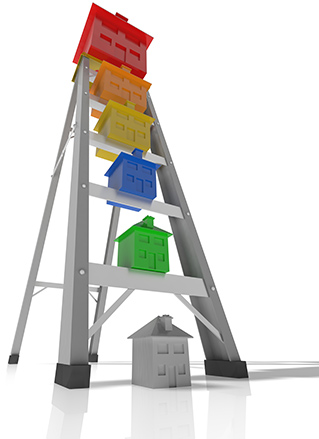
This tool will help you figure the date of your 45 and 180 day deadlines for performing a 1031 exchange. We also offer a 1031 exchange calculator.
45 Day Deadline: You must identify your replacement properties to your qualified intermediary by midnight of the 45th calendar day following the close of selling the property.
180 Day Deadline: You must complete your 1031 Exchange, including conveyance of title to all of your replacement properties you intend to acquire, no later than the earlier of:
For your convenience we list current Fairfield mortgage rates to help real estate investors estimate monthly loan payments & find local lenders.
The following table shows current Fairfield 30-year mortgage rates. You can use the menus to select other loan durations, alter the loan amount, change your down payment, or change your location. More features are available in the advanced drop down
A 1031 exchange lets you defer payment on all capital gains taxes when you sell a property and use the proceeds to invest in another similar property.
It's like an interest-free loan from the IRS, and it has one added benefit - it allows you to reinvest ALL of your equity in a new property, meaning you can afford more investment property. Thus, the real benefit of a swap is in its ability to increase your buying power.
For simplification, we'll call the real estate sold by the investor (the relinquished property) the old real estate, and we’ll refer to the purchased property as the new property. The process of exchanging will be called trading up because you can, in fact, trade up from a single family dwelling to a multi-unit apartment complex, or from a vacant lot to a commercial building.
For example, if you earn a capital gain of $250,000 on a property and merely sell it off, you only get what's left after the taxes are paid. If the total tax liability was $60,000 when the property was sold, you would only have $190,000 in your pocket to invest.
 But if you take advantage of the 1031 exchange, you would have the entire $250,000 to invest in a new property, as the taxes owed would be deferred. There are two main timelines for trading up.
But if you take advantage of the 1031 exchange, you would have the entire $250,000 to invest in a new property, as the taxes owed would be deferred. There are two main timelines for trading up.
The reverse exchange happens when you close on the purchase of the new real estate before closing on the sale of the old. Investors sometimes exercise this option if they are property hunting in a seller's market. If the investor is eyeing a property, which has received many offers, they may want to act fast to close the deal.
This is the most common 1031 format, giving an investor up to 180 days to purchase the new real estate. It requires the services of a professional qualified intermediary to prepare and process the paperwork, and it also requires you to make your choice of a new property within 45 days. This choice is referred to as identifying the property.
Actually, when you sell the old property and agree to trade up to a new one in exchange for deferment of your capital gains tax, you have 180 days or less to complete the deal. The letter of the law states that an exchanger has a maximum of 180 calendar days, or until their tax filing deadline, whichever comes first.
Furthermore, the time constraints for identifying the new property are very specific, giving you until midnight of the 45th day after closing on the sale of the old property to choose the new one. This 45-day deadline is called the identification period and is part of the 180-day swap period.
Both options allow you to reinvest more of your equity, but each has its own merits. A delayed exchange buys you some time to shop around and/or get your ducks in a row, but a reverse swap frees you from worrying about deadlines - and stops you from drawing big circles on your wall calendar.
1031 tax-deferred swaps allow real estate investors to defer paying capital gains taxes when they sell a property that is used "for productive use in a trade or business," or for investment.
This is due to IRC Section 1031, and when structured correctly, it lets you sell a property and reinvest the proceeds in a new property - while deferring all capital gains taxes.
First, let's look at the letter of the law and see how it applies to the average investor:
(a) Non-recognition of gain or loss from exchanges solely in kind --
(1) In general --
No gain or loss shall be recognized on the exchange of property held for productive use in a trade or business or for investment if such property is exchanged solely for property of like kind which is to be held either for productive use in a trade or business or for investment.
By avoiding capital gains taxes when you sell a property to reinvest in another similar property, you get to keep 100% of your equity. But there are other reasons to take advantage of swaps.

Let's suppose you have a capital gain of $200,000 and incur combined taxes from federal and state capital gains taxes, and a depreciation recapture of $70,000 when the property is sold. That leaves you with only $130,000 to invest in another property.
In this scenario, you would only be able to purchase a property worth $520,000. This is based on a down payment of 25% and a loan-to-value ratio of 75%.
However, if you chose to switch, you would have the entire $200,000 equity to sink into a new property, which would allow you to buy $800,000 worth of real estate - using the same down payment percentage and loan-to-value ratio.
We can see here that the 1013 arrangement is a form of protection because it shields investors from capital gains taxes, and it offers a greater return on investment. In order to take full advantage of these programs, it's important to understand them fully.
For example, the wording of the swap is open to interpretation, and this can help you expand and diversify your portfolio. Specifically, the phrase "property of like kind" is sometimes (mistakenly) taken to mean the same type of building, but it actually includes many different kinds of properties.
Calculating the amount of capital gains taxes owed when you sell a property is a three-step process. Firstly, take the original purchase price, add the cost of improvements, and subtract the depreciation amount. This gives you the net adjusted basis.
Next, you need to determine your actual capital gain by taking the sales price and subtracting both the net adjusted basis and the cost of sale. Now that you have your capital gain, you need to calculate the amount owed.
Finally, use a recaptured depreciation tax rate of 25%, the maximum capital gains tax rate of 15%, and then add the state tax rate (if applicable). The total of the depreciation recapture, the federal tax, and the state tax gives you the amount due for your capital gains tax.
If you do an exchange, you are permitted to name more than one replacement property, but you are limited by the following three rules:
A 1031 arrangement allows you to defer all of your capital gains taxes. And this amounts to getting a long-term and interest-free loan from the Internal Revenue Service. The real advantage is not just in tax savings - investors who take advantage of 1031 provisions can acquire much more investment real estate than those who don't. The biggest plus is the buying power you';ll have.
When an investor closes on the purchase of the replacement property before they close on the sale of the old (relinquished) property, it's known as a reverse swap.
It';s a fantastic tool for investors who are looking to quickly replace their property in a seller's market when there may be many offers pending on the property.
There are several different options, including the parked replacement property option, the reverse improvement swap, and the parked relinquished property alternative.
Like-kind properties are those considered to have similar business or investment uses. Examples are:
A delayed switch is one in which the investor closes on the sale of their relinquished property on a certain date, and then purchases a replacement property at a later date. An investor has a maximum of 180 days, or their filing deadline (whichever comes first), to complete the purchase of the replacement property.
This is known as the exchange period, and there is also an identification period, which is limited to 45 days after closing on the old property. These 45 days of identification are included in the 180-day exchange period.
This allows you as an investor to make improvements on the replacement property using equity from the 1031. This is normally done through a qualified third party. By using this option, you can end up with a much more lucrative investment property than what's available on the market.
You can use your swap equity to do major renovations, capital improvements, or even build from the ground up - all financed by tax-deferred dollars.
A qualified intermediary (QI) is someone who facilitates your 1031 transaction. Of course, you should choose the person offering the highest security for the transaction proceeds that will be held in their possession during the exchange period.
This is very important because the federal government doesn't regulate qualified intermediaries, so you should do some diligent research. Find out how many years they've been in business, how many exchanges they've overseen, and how proficient they are as a whole.
Explore conventional mortgages, FHA loans, USDA loans, and VA loans to find out which option is right for you.
Check your options with a trusted Fairfield lender.
Answer a few questions below and connect with a lender who can help you save today!